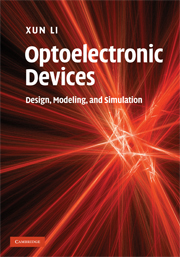Book contents
- Frontmatter
- Contents
- Preface
- 1 Introduction
- 2 Optical models
- 3 Material model I: Semiconductor band structures
- 4 Material model II: Optical gain
- 5 Carrier transport and thermal diffusion models
- 6 Solution techniques for optical equations
- 7 Solution techniques for material gain equations
- 8 Solution techniques for carrier transport and thermal diffusion equations
- 9 Numerical analysis of device performance
- 10 Design and modeling examples of semiconductor laser diodes
- 11 Design and modeling examples of other solitary optoelectronic devices
- 12 Design and modeling examples of integrated optoelectronic devices
- Appendices
- Index
12 - Design and modeling examples of integrated optoelectronic devices
Published online by Cambridge University Press: 09 October 2009
- Frontmatter
- Contents
- Preface
- 1 Introduction
- 2 Optical models
- 3 Material model I: Semiconductor band structures
- 4 Material model II: Optical gain
- 5 Carrier transport and thermal diffusion models
- 6 Solution techniques for optical equations
- 7 Solution techniques for material gain equations
- 8 Solution techniques for carrier transport and thermal diffusion equations
- 9 Numerical analysis of device performance
- 10 Design and modeling examples of semiconductor laser diodes
- 11 Design and modeling examples of other solitary optoelectronic devices
- 12 Design and modeling examples of integrated optoelectronic devices
- Appendices
- Index
Summary
The integrated semiconductor distributed feedback laser and electro-absorption modulator
The device structure
A schematic structure of an integrated semiconductor DFB laser and EAM is shown in Fig. 12.1.
The cross-sectional layer structures in the DFB and EAM sections are shown in Tables 12.1 and 12.2, respectively.
Both sections of this device are made of a ridge waveguide with the same ridge width of 2.0 μm, but with different ridge heights of 2.0 μm in the DFB laser section and 3.0 μm in the EAM section, respectively. Thus, the etched ditch stops on top of the laser active region but goes through the modulator active region. This design makes a better match of the effective indices between the DFB laser and EAM sections and hence the reflection from the interface between these two sections will be effectively reduced. The deep etching in the modulator section also improves the far-field pattern emitted from the front facet. Finally, by removing the EAM active region outside the ridge, the EAM insertion loss will reduce and its extinction ratio will increase as shown in Section 11.1.3.
The laser section and the modulator section are 300 μm and 200 μm long, respectively, the electrodes are isolated by a 10 μm wide and 1.0 μm deep trench etched across the ridge. The DFB laser has a uniform purely index-coupled grating with a normalized coupling coefficient of 4. This design is a balance between the output optical power, immunity to feedback from the modulator, and the lasing wavelength uncertainty in a range roughly equal to the Bragg stop-band width.
- Type
- Chapter
- Information
- Optoelectronic DevicesDesign, Modeling, and Simulation, pp. 313 - 331Publisher: Cambridge University PressPrint publication year: 2009



